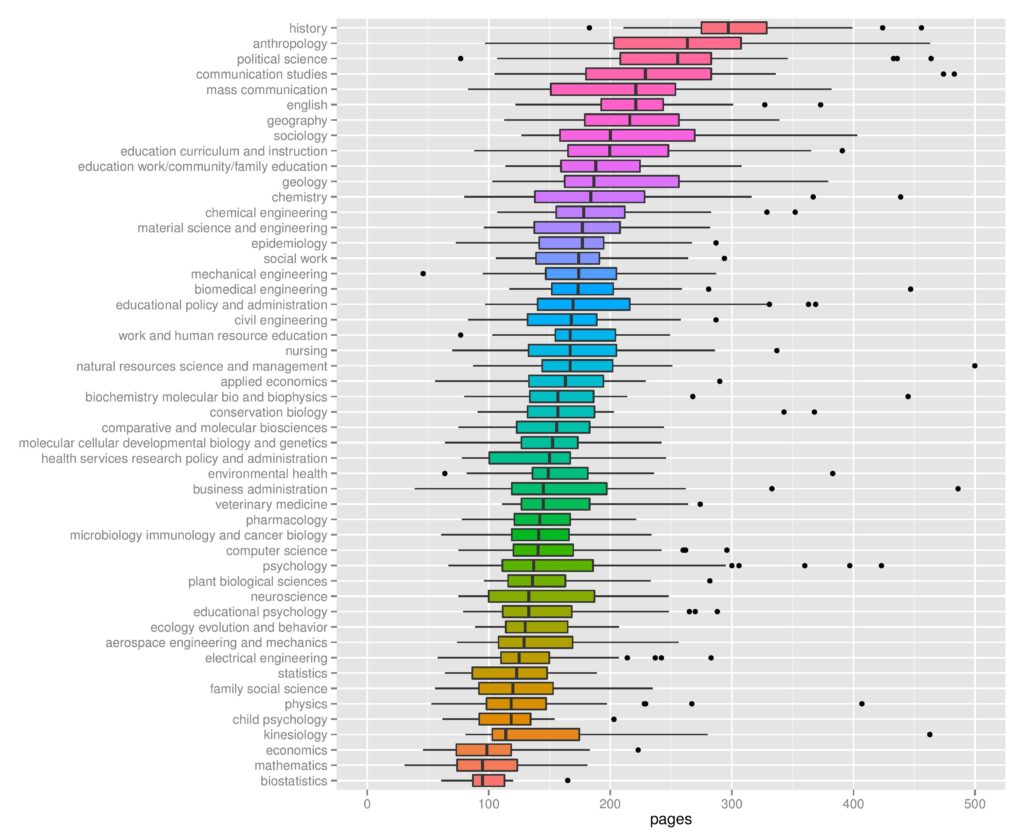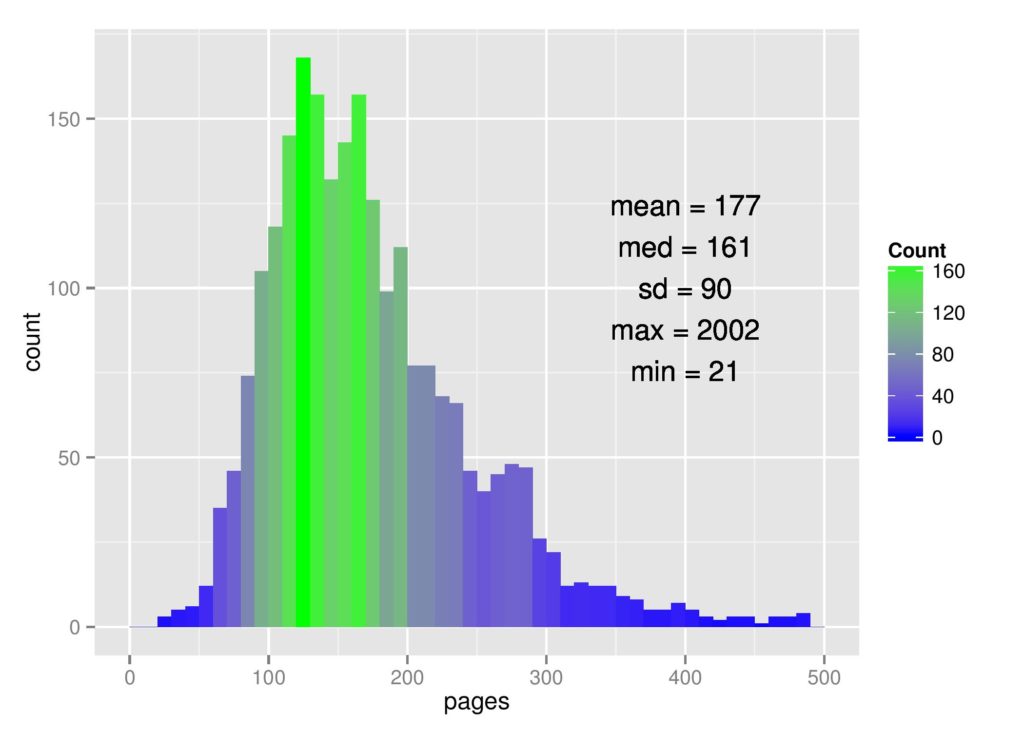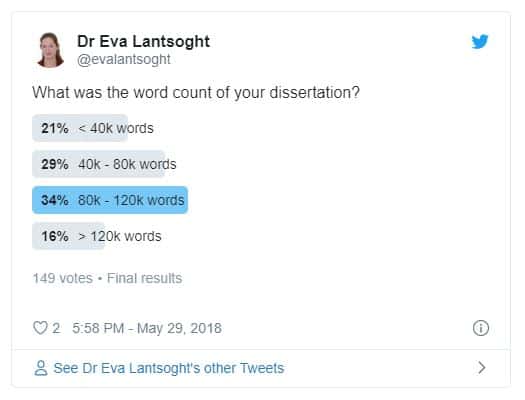Frequently asked questions
How long is a dissertation.
Dissertation word counts vary widely across different fields, institutions, and levels of education:
- An undergraduate dissertation is typically 8,000–15,000 words
- A master’s dissertation is typically 12,000–50,000 words
- A PhD thesis is typically book-length: 70,000–100,000 words
However, none of these are strict guidelines – your word count may be lower or higher than the numbers stated here. Always check the guidelines provided by your university to determine how long your own dissertation should be.

Frequently asked questions: Dissertation
A dissertation prospectus or proposal describes what or who you plan to research for your dissertation. It delves into why, when, where, and how you will do your research, as well as helps you choose a type of research to pursue. You should also determine whether you plan to pursue qualitative or quantitative methods and what your research design will look like.
It should outline all of the decisions you have taken about your project, from your dissertation topic to your hypotheses and research objectives , ready to be approved by your supervisor or committee.
Note that some departments require a defense component, where you present your prospectus to your committee orally.
A thesis is typically written by students finishing up a bachelor’s or Master’s degree. Some educational institutions, particularly in the liberal arts, have mandatory theses, but they are often not mandatory to graduate from bachelor’s degrees. It is more common for a thesis to be a graduation requirement from a Master’s degree.
Even if not mandatory, you may want to consider writing a thesis if you:
- Plan to attend graduate school soon
- Have a particular topic you’d like to study more in-depth
- Are considering a career in research
- Would like a capstone experience to tie up your academic experience
The conclusion of your thesis or dissertation should include the following:
- A restatement of your research question
- A summary of your key arguments and/or results
- A short discussion of the implications of your research
The conclusion of your thesis or dissertation shouldn’t take up more than 5–7% of your overall word count.
For a stronger dissertation conclusion , avoid including:
- Important evidence or analysis that wasn’t mentioned in the discussion section and results section
- Generic concluding phrases (e.g. “In conclusion …”)
- Weak statements that undermine your argument (e.g., “There are good points on both sides of this issue.”)
Your conclusion should leave the reader with a strong, decisive impression of your work.
While it may be tempting to present new arguments or evidence in your thesis or disseration conclusion , especially if you have a particularly striking argument you’d like to finish your analysis with, you shouldn’t. Theses and dissertations follow a more formal structure than this.
All your findings and arguments should be presented in the body of the text (more specifically in the discussion section and results section .) The conclusion is meant to summarize and reflect on the evidence and arguments you have already presented, not introduce new ones.
A theoretical framework can sometimes be integrated into a literature review chapter , but it can also be included as its own chapter or section in your dissertation . As a rule of thumb, if your research involves dealing with a lot of complex theories, it’s a good idea to include a separate theoretical framework chapter.
A literature review and a theoretical framework are not the same thing and cannot be used interchangeably. While a theoretical framework describes the theoretical underpinnings of your work, a literature review critically evaluates existing research relating to your topic. You’ll likely need both in your dissertation .
While a theoretical framework describes the theoretical underpinnings of your work based on existing research, a conceptual framework allows you to draw your own conclusions, mapping out the variables you may use in your study and the interplay between them.
A thesis or dissertation outline is one of the most critical first steps in your writing process. It helps you to lay out and organize your ideas and can provide you with a roadmap for deciding what kind of research you’d like to undertake.
Generally, an outline contains information on the different sections included in your thesis or dissertation , such as:
- Your anticipated title
- Your abstract
- Your chapters (sometimes subdivided into further topics like literature review , research methods , avenues for future research, etc.)
When you mention different chapters within your text, it’s considered best to use Roman numerals for most citation styles. However, the most important thing here is to remain consistent whenever using numbers in your dissertation .
In most styles, the title page is used purely to provide information and doesn’t include any images. Ask your supervisor if you are allowed to include an image on the title page before doing so. If you do decide to include one, make sure to check whether you need permission from the creator of the image.
Include a note directly beneath the image acknowledging where it comes from, beginning with the word “ Note .” (italicized and followed by a period). Include a citation and copyright attribution . Don’t title, number, or label the image as a figure , since it doesn’t appear in your main text.
Definitional terms often fall into the category of common knowledge , meaning that they don’t necessarily have to be cited. This guidance can apply to your thesis or dissertation glossary as well.
However, if you’d prefer to cite your sources , you can follow guidance for citing dictionary entries in MLA or APA style for your glossary.
A glossary is a collection of words pertaining to a specific topic. In your thesis or dissertation, it’s a list of all terms you used that may not immediately be obvious to your reader. In contrast, an index is a list of the contents of your work organized by page number.
The title page of your thesis or dissertation goes first, before all other content or lists that you may choose to include.
The title page of your thesis or dissertation should include your name, department, institution, degree program, and submission date.
Glossaries are not mandatory, but if you use a lot of technical or field-specific terms, it may improve readability to add one to your thesis or dissertation. Your educational institution may also require them, so be sure to check their specific guidelines.
A glossary or “glossary of terms” is a collection of words pertaining to a specific topic. In your thesis or dissertation, it’s a list of all terms you used that may not immediately be obvious to your reader. Your glossary only needs to include terms that your reader may not be familiar with, and is intended to enhance their understanding of your work.
A glossary is a collection of words pertaining to a specific topic. In your thesis or dissertation, it’s a list of all terms you used that may not immediately be obvious to your reader. In contrast, dictionaries are more general collections of words.
An abbreviation is a shortened version of an existing word, such as Dr. for Doctor. In contrast, an acronym uses the first letter of each word to create a wholly new word, such as UNESCO (an acronym for the United Nations Educational, Scientific and Cultural Organization).
As a rule of thumb, write the explanation in full the first time you use an acronym or abbreviation. You can then proceed with the shortened version. However, if the abbreviation is very common (like PC, USA, or DNA), then you can use the abbreviated version from the get-go.
Be sure to add each abbreviation in your list of abbreviations !
If you only used a few abbreviations in your thesis or dissertation , you don’t necessarily need to include a list of abbreviations .
If your abbreviations are numerous, or if you think they won’t be known to your audience, it’s never a bad idea to add one. They can also improve readability, minimizing confusion about abbreviations unfamiliar to your reader.
A list of abbreviations is a list of all the abbreviations that you used in your thesis or dissertation. It should appear at the beginning of your document, with items in alphabetical order, just after your table of contents .
Your list of tables and figures should go directly after your table of contents in your thesis or dissertation.
Lists of figures and tables are often not required, and aren’t particularly common. They specifically aren’t required for APA-Style, though you should be careful to follow their other guidelines for figures and tables .
If you have many figures and tables in your thesis or dissertation, include one may help you stay organized. Your educational institution may require them, so be sure to check their guidelines.
A list of figures and tables compiles all of the figures and tables that you used in your thesis or dissertation and displays them with the page number where they can be found.
The table of contents in a thesis or dissertation always goes between your abstract and your introduction .
You may acknowledge God in your dissertation acknowledgements , but be sure to follow academic convention by also thanking the members of academia, as well as family, colleagues, and friends who helped you.
A literature review is a survey of credible sources on a topic, often used in dissertations , theses, and research papers . Literature reviews give an overview of knowledge on a subject, helping you identify relevant theories and methods, as well as gaps in existing research. Literature reviews are set up similarly to other academic texts , with an introduction , a main body, and a conclusion .
An annotated bibliography is a list of source references that has a short description (called an annotation ) for each of the sources. It is often assigned as part of the research process for a paper .
In a thesis or dissertation, the discussion is an in-depth exploration of the results, going into detail about the meaning of your findings and citing relevant sources to put them in context.
The conclusion is more shorter and more general: it concisely answers your main research question and makes recommendations based on your overall findings.
In the discussion , you explore the meaning and relevance of your research results , explaining how they fit with existing research and theory. Discuss:
- Your interpretations : what do the results tell us?
- The implications : why do the results matter?
- The limitation s : what can’t the results tell us?
The results chapter or section simply and objectively reports what you found, without speculating on why you found these results. The discussion interprets the meaning of the results, puts them in context, and explains why they matter.
In qualitative research , results and discussion are sometimes combined. But in quantitative research , it’s considered important to separate the objective results from your interpretation of them.
Results are usually written in the past tense , because they are describing the outcome of completed actions.
The results chapter of a thesis or dissertation presents your research results concisely and objectively.
In quantitative research , for each question or hypothesis , state:
- The type of analysis used
- Relevant results in the form of descriptive and inferential statistics
- Whether or not the alternative hypothesis was supported
In qualitative research , for each question or theme, describe:
- Recurring patterns
- Significant or representative individual responses
- Relevant quotations from the data
Don’t interpret or speculate in the results chapter.
To automatically insert a table of contents in Microsoft Word, follow these steps:
- Apply heading styles throughout the document.
- In the references section in the ribbon, locate the Table of Contents group.
- Click the arrow next to the Table of Contents icon and select Custom Table of Contents.
- Select which levels of headings you would like to include in the table of contents.
Make sure to update your table of contents if you move text or change headings. To update, simply right click and select Update Field.
All level 1 and 2 headings should be included in your table of contents . That means the titles of your chapters and the main sections within them.
The contents should also include all appendices and the lists of tables and figures, if applicable, as well as your reference list .
Do not include the acknowledgements or abstract in the table of contents.
The abstract appears on its own page in the thesis or dissertation , after the title page and acknowledgements but before the table of contents .
An abstract for a thesis or dissertation is usually around 200–300 words. There’s often a strict word limit, so make sure to check your university’s requirements.
In a thesis or dissertation, the acknowledgements should usually be no longer than one page. There is no minimum length.
The acknowledgements are generally included at the very beginning of your thesis , directly after the title page and before the abstract .
Yes, it’s important to thank your supervisor(s) in the acknowledgements section of your thesis or dissertation .
Even if you feel your supervisor did not contribute greatly to the final product, you must acknowledge them, if only for a very brief thank you. If you do not include your supervisor, it may be seen as a snub.
In the acknowledgements of your thesis or dissertation, you should first thank those who helped you academically or professionally, such as your supervisor, funders, and other academics.
Then you can include personal thanks to friends, family members, or anyone else who supported you during the process.
Ask our team
Want to contact us directly? No problem. We are always here for you.
- Email [email protected]
- Start live chat
- Call +1 (510) 822-8066
- WhatsApp +31 20 261 6040

Our team helps students graduate by offering:
- A world-class citation generator
- Plagiarism Checker software powered by Turnitin
- Innovative Citation Checker software
- Professional proofreading services
- Over 300 helpful articles about academic writing, citing sources, plagiarism, and more
Scribbr specializes in editing study-related documents . We proofread:
- PhD dissertations
- Research proposals
- Personal statements
- Admission essays
- Motivation letters
- Reflection papers
- Journal articles
- Capstone projects
Scribbr’s Plagiarism Checker is powered by elements of Turnitin’s Similarity Checker , namely the plagiarism detection software and the Internet Archive and Premium Scholarly Publications content databases .
The add-on AI detector is powered by Scribbr’s proprietary software.
The Scribbr Citation Generator is developed using the open-source Citation Style Language (CSL) project and Frank Bennett’s citeproc-js . It’s the same technology used by dozens of other popular citation tools, including Mendeley and Zotero.
You can find all the citation styles and locales used in the Scribbr Citation Generator in our publicly accessible repository on Github .
- 1-888-SNU-GRAD
- Daytime Classes

The 8 Most Asked Questions About Dissertations

A Ph.D. represents the highest level of education in most fields. People who earn this degree earn the honorific of “doctor” and are considered experts in their field. A doctoral degree is often a prerequisite for teaching at the highest levels in academia or ascending career ladders in education, the government and the nonprofit space.
In 2020 , doctoral degree holders had median weekly earnings of $1,885 and an unemployment rate of 2.5%—lower than any other group. And yet, the dissertation is often a major barrier to completing a doctorate and realizing its many financial and personal benefits.
So what is a dissertation, and what role does it play in your educational trajectory? At SNU, we value exceptional dissertations and integrate the writing process into your coursework. Here are the most common questions we hear about writing dissertations and earning your doctorate.
1. What is a dissertation?
A dissertation is a published piece of academic research. Through your dissertation research , you become an expert in a specific academic niche. After writing your dissertation, you then defend it to a committee of experts in the field. A dissertation is integral to the process of earning a doctoral degree, contributing innovative ideas to your chosen field. Until you have written, published and defended a dissertation, you can’t graduate from a doctoral-level program.
2. Why are dissertations so important?
Dissertations are the crucial piece of research in most doctoral-level programs. The process of writing, researching and amending the dissertation serves several important goals:
- It contributes novel research to the field, supporting innovation, growth and ongoing scholarship.
- It requires students to write a substantive piece of academic research across many semesters, sharpening research skills and expertise.
- It demands that s tudents defend their research, ensuring strong communication and critical thinking skills.
- It requires deep, comprehensive research—including a literature review—improving reading comprehension and writing skills.
- It is a challenging project that serves as a test of the skills you might use as an academic professional in your chosen field.
- It helps establish new members of an academic discipline as contributors to the field.
- It fosters academic connections as you interview sources and defend your work.
3. Why do so many students struggle with the dissertation?
The dissertation process is difficult. However, this difficulty establishes the credibility of doctoral degrees, proving that the student can commit to long-term, intensive research and become a true subject-matter expert.
However, for many adult learners, the dissertation proves especially challenging thanks to work-life balance difficulties, financial constraints and lack of family or institutional support. At SNU, we know that a dissertation is critical to your growth as an academic. But we also know that institutional support can make a big difference in your ability to finish this impressive work. That’s why we integrate dissertation writing into our curriculum, rather than leaving you to do it all on your own time.
One study suggests that more than half of students never complete their dissertation. Other research indicates that academic reforms that help students with their work reduce dropout rates, ensuring more students complete their dissertation and earn the coveted title of doctor.
4. How long is a dissertation?
Most dissertations are 100 pages or longer — roughly the length of a book. The specific length of your dissertation depends on the type of research, how much research exists in the field and similar factors. The goal of dissertation writing is not to attain a specific length, but to be comprehensive and thoughtful. It anticipates and answers potential objections, gives appropriate credit to the source materials and reviews prior work in the field.
Your dissertation review committee is more interested in a comprehensive dissertation that displays your critical thinking and research skills than they are in a dissertation of a specific length. Excessive wordiness without value wastes a reader’s time.
The right length for a dissertation depends on several factors:
- How much research already exists in the field?
- What field are you publishing in?
- What type of research are you doing?
- Is your research controversial?
- How much space do you need to explain your research and address objections?
Put simply: A dissertation should be long enough to comprehensively cover the subject, but no longer.
5. How do you write a dissertation?
In general, the dissertation process follows this schedule:
- Research the field and identify potential topics.
- Meet with an advisor to choose and improve a topic.
- Perform a literature review.
- Conduct new research.
- Write the dissertation.
- Edit the dissertation.
- Defend the dissertation.
Each step involves weeks to months of work and many phases of revision, reevaluation and research. At SNU, we incorporate many phases of the writing and research process into your coursework. This ensures you are on track to graduate and addresses dissertation writing challenges before they snowball into a serious problem.
6. When should you start writing a dissertation?
The dissertation writing process should begin almost as soon as you enroll in school. That doesn’t necessarily mean you need to have content written on your first day of class. Instead, you will need to engage in substantive pre-writing that includes:
- Familiarizing yourself with relevant research in the field.
- Developing an opinion on recent research.
- Designing your research to address a clear and narrowly defined topic.
As you hone in on your topic, you can begin the writing and research portion of the project. In most cases, this starts within a semester or two of enrollment. A dissertation is not something you can leave until the last semester or shortly before graduation. SNU ensures this doesn’t happen by integrating the writing process into your coursework. You will start working on your dissertation early, preventing you from becoming overwhelmed.
7. How do you cite a dissertation?
A dissertation is a published scholarly work. Each style manual has specific instructions for citing a dissertation, so be sure to consult the style manual you’re using.
You can cite other dissertations in your dissertation. In many cases, dissertations can provide useful starting points for your research. The literature reviews they contain may also help with your literature review.
8. How do you choose a school for your dissertation?
Choosing the right school for your dissertation can mean the difference between finishing this scholarly work and languishing at the dreaded “ all-but-dissertation” (ABD) stage . SNU specializes in supporting adult learners by encouraging intensive research and protecting your work-life balance.
At SNU, your dissertation is a part of your coursework . You will get support from start to finish, including a dissertation advisor who is an expert in your chosen field. We are here for you, and we want to see you succeed.

Want to learn more about SNU's programs?
Request more information.
Have questions about SNU, our program, or how we can help you succeed. Fill out the form and an enrollment counselor will reach out to you soon!
Subscribe to the SNU blog for inspirational articles and tips to support you on your journey back to school.
Recent blog articles.

Adult Education
How a Master of Arts in Educational Leadership Can Elevate Your Career

Caring with Purpose: The Role of Christian Principles in SNU’s PTA Program

Exploring Graduate Programs in Rehabilitation and Sport Sciences

Julia Monroe Takes the Helm of the Master of Arts in Teaching Program
Have questions about SNU or need help determining which program is the right fit? Fill out the form and an enrollment counselor will follow-up to answer your questions!
Text With an Enrollment Counselor
Have questions, but want a faster response? Fill out the form and one of our enrollment counselors will follow-up via text shortly!

How long is a PhD dissertation? [Data by field]
The final piece of the PhD journey is the PhD dissertation. It takes many years to accumulate enough original and new data to fill out a dissertation to the satisfaction of experts in your field. Interestingly, the PhD dissertation length and content vary significantly based on the field you are studying and the publishing conventions.
A PhD can be anywhere from 50 pages to over 450 pages long. This equates to between about 20,000 words to 100,000 words. Most PhD theses are between 60,000 and 80,000 words long excluding contents, citations and references.
A PhD thesis contains different sections including an introduction, methods, results and discussion, conclusions, further work, and references. Each one of these different sections will vary in length depending on the field of study and your particular topic.
Ultimately, a PhD dissertation should contain as many pages and words as it takes to communicate the results of your multi-year investigation.
It is very rewarding to see your thesis come together as you are writing day after day. When I was writing my PhD dissertation I wrote the sections separately and my heart filled with joy when I finally put them all together and compile them into a single PDF document.
Counting the pages should not be the way to determine a PhD dissertation’s value but it certainly helps when your thesis is starting to look substantial in thickness.
How many pages should a PhD dissertation be?
A PhD dissertation should contain as many pages and words as it takes to outline the current state of your field and provide adequate background information, present your results, and provide confidence in your conclusions. A PhD dissertation will also contain figures, graphs, schematics, and other large pictorial items that can easily inflate the page count.
Here is a boxplot summary of many different fields of study and the number of pages of a typical PhD dissertation in the field. It has been created by Marcus Beck from all of the dissertations at the University of Minnesota.

Typically, the mathematical sciences, economics, and biostatistics theses and dissertations tend to be shorter because they rely on mathematical formulas to provide proof of their results rather than diagrams and long explanations.
On the other end of the scale, English, communication studies, political science, history and anthropology are often the largest theses in terms of pages and word count because of the number of words it takes to provide proof and depth of their results.
At the end of the day, it is important that your thesis gets signed off by your review committee and other experts in the field. Your supervisor will be the main judge of whether or not your dissertation is capable of satisfying the requirements of a PhD in your field.
If you want to know more about how long a Masters’s thesis and PhD dissertation is you can check out my other articles:
- How Long is a Masters Thesis? [Your writing guide]
- How long is a Thesis or dissertation? [the data]
Can a PhD dissertation be too long?
A PhD thesis should contain enough evidence and discussion to report on the most significant findings of your PhD research.
A PhD dissertation should not contain everything that you have done during your PhD. It should only include the data and information required to convince your PhD examining body that wraps up and tells the full story of particular lines of investigation.
Including random results, thoughts, or superfluous explanation can result in a dissertation that is unfocused. I have heard of music PhD is being described as too verbose and physical sciences PhD dissertations as being unfocused.
Therefore, a PhD thesis can be too long if the information it contains does not form a full and cohesive story.
One of my colleagues during their PhD removed an entire chapter from the thesis after writing it as the supervisor said that it needed more experiments to be a full story. They did not want to spend the next six months gathering the data and simply removed the chapter altogether.
How short can PhD dissertation be?
The shortest PhD dissertations are typically found in mathematics.
George Bernard Danzig was an American mathematical scientist who made contributions to industrial engineering and many other mathematical-related fields. An interesting miscommunication led to 1 of the shortest PhD theses ever.
In 1939 his professor wrote two problems on the blackboard and Danzig thought they were homeless assignments. He stated that they were harder than usual but handed in solutions to the surprise of the professor.
They were, in fact, open mathematical problems in statistics.
His professor said to bind the solution to the two problems together and submit them as his thesis – the total thesis length = 14 pages.
Obviously, most PhD theses and dissertations will be so much longer than that!
My PhD dissertation was 256 pages long. It was full of schematics, diagrams, and tables to demonstrate and communicate my findings.
I would say that most people’s PhD thesis experience will be closer to mine than Prof George Bernard Danzig’s.
Why PhD dissertations are typically so long
PhD dissertations are often over 200 pages long.
One of the primary reasons they are so long is that it is a single document that summarises many years of hard work. Also, summarising the research field to date and making sure that all of your references and citations are included so you avoid plagiarism will bolster the word count of the thesis dramatically.
Here are all of the reasons PhD dissertations tend to be so long.
Many years of work
PhD theses or dissertations contain many years of research and analysis.
In many of my YouTube videos I recommend that a PhD student work towards their PhD thesis by doing at least three hours of focused work every work day.
This amount of work quickly adds up.
Of course, not every bit of work makes it into the PhD dissertation but a lot of it does. It can be difficult to work out what to include or leave out of your thesis.
As a PhD student, I perfected the art of turning one experiment into many different types of grafts and schematics to fully explore the limits of my data. The graphs can take up a lot of space in your PhD thesis and, therefore, bolster the page count significantly.
In depth literature review
One of the most substantial parts of a PhD dissertation is the literature review.
The literature review can take up a huge portion of the early part of your PhD dissertation depending on the amount of data and publications in your field.
Writing an in-depth literature review requires just as much meticulous data analysis and searching as the central part of your dissertation.
Figures and schematics
Some fields end up producing a lot of figures and schematics.
My thesis had many full-page figures of atomic force microscopy experiments with much more explanation on subsequent pages.

As they say, a picture paints a thousand words and a dissertation can really benefit from having many schematics to highlight the important aspects of your findings.
References and citations
The recommended PhD dissertation word count from an institution or university does not include citations, references, or other thesis parts such as summary of abbreviations, table of figures, et cetera.
However, these components of your dissertation can take up many pages and add to the overall thickness of your PhD dissertation.
University formatting rules
University formatting rules will also dictate how you many pages your words take up.
I often get roasted on my YouTube channel for having doublespaced lines and wide margins. Unfortunately, this layout was dictated by my university before printing.
PhD dissertations often end up going into long-term storage and therefore, need to adhere to archival and standardised formatting rules.
Deep in the depths of the University of Newcastle, there is a copy of my thesis on a shelf. The formatting and binding rules mean that my thesis looks like everyone else’s.
Universities will often have their own requirements for PhD dissertation cover colour, quality, and type of paper. Even the quality of the paper can change the thickness of the PhD dissertation significantly.
PhD by publication
It is becoming increasingly common to submit a number of peer-reviewed papers bound together with supplementary information in between instead of a PhD dissertation.
The benefits of this to the researcher and university are:
- More early career peer-reviewed journals for career advancement
- an easier review process – they have already been peer-reviewed
- an early focus on publishing means better research outcomes for the researcher, supervisor, and Department.
- No mad rush at the end to finish a thesis
- continually writing peer-reviewed papers throughout your PhD helps with timely analysis and communication of results
Even though this option has been available to PhD students for a number of years, I have only known a handful of students actually submit their PhD via publication.
Nonetheless, having this option will suit some research fields better than others and lead to a more productive PhD.
Wrapping up
This article has been through everything you need to know about the length of a PhD dissertation and the common lengths of PhD dissertations for various fields.
Ultimately, there is no predefined length of a PhD .
A PhD thesis is as long as it needs to be to convince your examiners that you have contributed significantly enough to an academic field to be awarded the title of Dr of philosophy.
Mathematical and analytical theses tend to be shorter and can be as short as 50 pages (with one of the shortest being only 14 pages long). At the other end of the spectrum, PhD students in anthropology and history tend to produce the longest dissertations.

Dr Andrew Stapleton has a Masters and PhD in Chemistry from the UK and Australia. He has many years of research experience and has worked as a Postdoctoral Fellow and Associate at a number of Universities. Although having secured funding for his own research, he left academia to help others with his YouTube channel all about the inner workings of academia and how to make it work for you.
Thank you for visiting Academia Insider.
We are here to help you navigate Academia as painlessly as possible. We are supported by our readers and by visiting you are helping us earn a small amount through ads and affiliate revenue - Thank you!

2024 © Academia Insider

Want to Get your Dissertation Accepted?
Discover how we've helped doctoral students complete their dissertations and advance their academic careers!
Join 200+ Graduated Students

Get Your Dissertation Accepted On Your Next Submission
Get customized coaching for:.
- Crafting your proposal,
- Collecting and analyzing your data, or
- Preparing your defense.
Trapped in dissertation revisions?
How long is a dissertation, published by steve tippins on april 9, 2019 april 9, 2019.
Last Updated on: 2nd February 2024, 05:03 am
How long is a dissertation? This is a question that almost every doctoral student asks at some point. It is not a new question–in fact, it’s been asked every time a paper of some sort is assigned in any class.
The simple answer (for any paper) is, “long enough to answer the question.” Not a really helpful answer, but satisfying from a professor’s perspective.
The truth is, there is no one answer to how long a dissertation is. I can’t say 146 pages is what’s needed, as you may write to page 146 and stop without fully exploring your topic. 90 pages could adequately address your research question, or you could write 200 pages and still not fully answer what you set out to. Every topic is unique, as is each person’s writing style.
Some websites even give specific answers that are simply inaccurate. In my experience, dissertations vary too much to be pinned down like that.
However, there are some practical suggestions I can make about how long your dissertation should be, how to adequately address the requirements of each section, as well as how to expand or reduce the length of specific chapters according to your needs. I’ll explore these below.
But first, let’s try and at least give the beginning of an answer to the question “how long is a dissertation?”
Marcus Beck Sets Out to Answer “How Long Is A Dissertation?”
Any discussion of dissertation length must include the work done by Marcus Beck . As a way to distract himself from his own dissertation writing, Beck calculated the average length of dissertations in the University of Minnesota database.

You can see from looking at his data that average length varies by discipline. So the first answer to how long a dissertation is, is that it depends upon what area you are writing your dissertation. It appears that a dissertation in History will be much longer, on average, than one in Chemistry. He also calculated the average across all disciplines.

Don’t be intimidated by how long the average dissertation is.
Many people look at the average length of a dissertation and get intimidated by the high page count. But, as Marcus Beck says in his blog post, “The actual written portion may only account for less than 50% of the page length.”
I’ve found this to be true. References, appendixes, tables and figures, page breaks, and white space all contribute to the high page count. The actual number of words you need to write is likely considerably less than the page count initially implies.
How Long Should My Dissertation Be?
Even though there’s no single answer about how long a dissertation should be, there probably is an ideal range which your dissertation falls into. This depends on your topic of research, but also on other factors. I’ll discuss some of these below.
Institutional Guidelines
I know of schools that have policies such as “Chapter 2 must be at least 40 pages long and no more than 60 pages.” Why this type of requirement? In my mind, there are two reasons.
First, they want to give some sort of guideline for students that is helpful but does not overburden faculty (a 230-page lit review is daunting to read).
Second, credibility is important. An 8-page lit review does not reflect well upon the student or the institution.
Most schools now have a dissertation template with the headings that are needed for most sections. If you take the time to completely fill in the headings with all of the relevant information, you should come up with an adequate number of pages. Remember, in academic writing, we don’t leave much to chance, we tell the reader everything.
Committee Preferences
It is likely that you will get a committee member who will give you priceless advice such as, “more is needed here.” When you get this type of comment it can be frustrating as specific feedback can be much more helpful.
Usually, what a committee member means by comments like this is that you haven’t really convinced the reader that you have fully explored the area or demonstrated a strong understanding of the material. So, expand what you are saying. Don’t imply anything, state it directly. This lets your committee know that you really do get it.
Sometimes you will get committee members giving contradictory advice. One member may want more information and another may want less. My first piece of advice is to negotiate these types of requests through your Chairperson.
This is where your Chair’s experience and guidance can be very helpful. Second, if a member really wants material included but others do not think it is very helpful, then adding the material in an appendix may make everyone happy.
Practical Suggestions For Dissertation Length, Chapter-By-Chapter

If you adequately and succinctly address each required section, you should end up with the right length for each chapter (and therefore, a dissertation of the right length). I’ll also give some rough guidelines on average page length where appropriate.
This is the introduction to your study. It is important to lay out the agenda for your research. Be sure that your problem statement, title, and research questions are in alignment (all referring to the same idea).
Chapter 1 tends to average in the 15-25 page range. If you get beyond 25 pages, you are usually including material that is better presented elsewhere in the dissertation.
Chapter 2 should thoroughly explore the existing research on your topic. However, it shouldn’t go on and on.
- If you are looking to beef up Chapter 2, it is always helpful to add research that supports the methodology that you are planning to use.
- If the chapter is too long, try to reduce the references you cite to those that are the most relevant and recent.
Make sure that you tell the reader what you did and how you did it. What type of analysis did you use and why? How many respondents were involved and how did you find them? The idea is to make sure that readers understand what you did and could replicate it if they want to.
As this is a plan for your research, it seems to naturally fall in the 15 to 20 page range.
The results of your study are presented here. Include all material that will help the reader understand what you found. There is a tendency to inundate the reader with tables, charts, and graphs. If they don’t directly relate to what you found or are redundant they can be included in an appendix. You don’t want to lose your reader in an avalanche of tables and numbers.
In most dissertations, it is Chapter 5 where you get to explain what the results of your research mean and the implications. This is the only chapter where you have some freedom to really express your opinions. Go ahead and do so.
I am always surprised when someone has spent 15 months of their life working on a research topic and they submit a Chapter 5 that is 8 pages long. Spread your wings and really explore what your results mean.

How Long is a Dissertation? Summary
The is no doubt about it, a dissertation is a long document. It is, however, not written in one sitting. You work on it for many months, crafting paragraphs and coming to conclusions. Many people find that because the document can be written in pieces that when it’s all put together, it is longer than expected. Keep writing and adding your thoughts and you will make it.
Many students find it helps to have a supportive guide who’s both been through the dissertation writing process before and is experienced in helping students. If that would be useful to you, feel free to reach out to me about my dissertation coaching or dissertation editing services.
Steve Tippins
Steve Tippins, PhD, has thrived in academia for over thirty years. He continues to love teaching in addition to coaching recent PhD graduates as well as students writing their dissertations. Learn more about his dissertation coaching and career coaching services. Book a Free Consultation with Steve Tippins
Related Posts

Dissertation
Dissertation memes.
Sometimes you can’t dissertate anymore and you just need to meme. Don’t worry, I’ve got you. Here are some of my favorite dissertation memes that I’ve seen lately. My Favorite Dissertation Memes For when you Read more…

Surviving Post Dissertation Stress Disorder
The process of earning a doctorate can be long and stressful – and for some people, it can even be traumatic. This may be hard for those who haven’t been through a doctoral program to Read more…

PhD by Publication
PhD by publication, also known as “PhD by portfolio” or “PhD by published works,” is a relatively new route to completing your dissertation requirements for your doctoral degree. In the traditional dissertation route, you have Read more…

- How Long Is a PhD Thesis?
- Doing a PhD
It’s no secret that one of the most challenging aspects of a PhD degree is the volume of work that goes into writing your thesis . So this raises the question, exactly how long is a thesis?
Unfortunately, there’s no one size fits all answer to this question. However, from the analysis of over 100 PhD theses, the average thesis length is between 80,000 and 100,000 words. A further analysis of 1000 PhD thesis shows the average number of pages to be 204 . In reality, the actual word count for each PhD thesis will depend on the specific subject and the university it is being hosted by. This is because universities set their own word length requirements, with most found to be opting for around 100,000.
To find out more about how these word limits differ between universities, how the average word count from STEM thesis differ from non-STEM thesis and a more detailed breakdown from the analysis of over 1000 PhDs, carry on reading the below.
Word Count Differences Between Universities
For any PhD student writing a thesis, they will find that their document will be subject to a word limit set by their university. In nearly all cases, the limit only concerns the maximum number of words and doesn’t place any restrictions on the minimum word limit. The reason for this is that the student will be expected to write their thesis with the aim of clearly explaining their research, and so it is up to the student to determine what he deems appropriate.
Saying this, it is well accepted amongst PhD students and supervisors that the absence of a lower limit doesn’t suggest that a thesis can be ‘light’. Your thesis will focus on several years worth of original research and explore new ideas, theories or concepts. Besides this, your thesis will need to cover a wide range of topics such as your literature review, research methodology, results and conclusion. Therefore, your examiners will expect the length of your thesis to be proportional to convey all this information to a sufficient level.
Selecting a handful of universities at random, they state the following thesis word limits on their website:
- University of Edinburgh: 100,000
- University of Exeter: 100,000
- University of Leister: 80,000
- University of Bath: 80,000
- University of Warwick: 70,000
The above universities set upper word limits that apply across the board, however, some universities, such as the University of Birmingham and the University of Sheffield, set different word limits for different departments. For example, the University of Sheffield adopts these limits:
- Arts & Humanities: 75,000
- Medicine, Dentistry & Health: 75,000
- Science: 80,000
- Social Sciences: 75,000-100,000
Although there’s a range of limit, it’s safe to say that the majority fall within the 80,000 to 100,000 bracket.
Word Count Based on Data from past Theses
A poll of 149 postdocs.
In mid-2019, Dr Eva Lantsoght, a published author, academic blogger and Structural Engineering Professor, conducted a poll which asked postgraduate doctoral students to share the length of their final thesis. 149 PostDoc students responded to the survey, with the majority reporting a length falling within the ‘80,000 – 120,000 words’ bracket as seen below.

Analysis of 1000 PhD Theses
Over a three-year time period, Dr Ian Brailsford, a then Postgraduate Learning Adviser at the University of Auckland, analysed 1000 doctoral thesis submitted to his university’s library. The PhD theses which formed the basis of his analysis were produced between 2008 to 2017 and showed:
- Average number of pages = 204
- Median number of pages = 198
- Average number of chapters = 7.6
We should note that the above metrics only cover the content falling within the main body of the thesis. This includes the introduction, literature review, methods section, results chapter, discussions and conclusions. All other sections, such as the title page, abstract, table of contents, acknowledgements, bibliography and appendices were omitted from the count.
Although it’s impossible to draw the exact word count from the number of pages alone, by using the universities recommended format of 12pt Times New Roman and 1.5 lines spacing, and assuming 10% of the main body are figures and footnotes, this equates to an average main body of 52,000 words.
STEM vs Non-STEM
As part of Dr Ian Brailsford’s analysis, he also compared the length of STEM doctorate theses to non-STEM theses. He found that STEM theses tended to be shorter. In fact, he found STEM theses to have a medium page length of 159 whilst non-STEM theses had a medium of around 223 pages. This is a 40% increase in average length!
Can You Exceed the Word Count?
Whilst most universities will allow you to go over the word count if you need to, it comes with the caveat that you must have a very strong reason for needing to do so. Besides this, your supervisor will also need to support your request. This is to acknowledge that they have reviewed your situation and agree that exceeding the word limit will be absolutely necessary to avoid detriment unnecessary detriment to your work.
This means that whilst it is possible to submit a thesis over 100,000 words or more, it’s unlikely that your research project will need to.
How Does This Compare to a Masters Dissertation?
The average Masters dissertation length is approximately 20,000 words whilst a thesis is 4 to 5 times this length at approximately 80,000 – 100,000.
The key reason for this difference is because of the level of knowledge they convey. A Master’s dissertation focuses on concluding from existing knowledge whilst a PhD thesis focuses on drawing a conclusion from new knowledge. As a result, the thesis is significantly longer as the new knowledge needs to be well documented so it can be verified, disseminated and used to shape future research.
Finding a PhD has never been this easy – search for a PhD by keyword, location or academic area of interest.
Related Reading
Unfortunately, the completion of your thesis doesn’t mark the end of your degree just yet. Once you submit your thesis, it’s time to start preparing for your viva – the all-to-fun thesis defence interview! To help you prepare for this, we’ve produced a helpful guide which you can read here: The Complete Guide to PhD Vivas.
Browse PhDs Now
Join thousands of students.
Join thousands of other students and stay up to date with the latest PhD programmes, funding opportunities and advice.
- Search All Scholarships
- Exclusive Scholarships
- Easy Scholarships to Apply For
- No Essay Scholarships
- Scholarships for HS Juniors
- Scholarships for HS Seniors
- Scholarships for College Students
- Scholarships for Grad Students
- Scholarships for Women
- Scholarships for Black Students
- Scholarships
- Student Loans
- College Admissions
- Financial Aid
- Scholarship Winners
- Scholarship Providers
Student-centric advice and objective recommendations
Higher education has never been more confusing or expensive. Our goal is to help you navigate the very big decisions related to higher ed with objective information and expert advice. Each piece of content on the site is original, based on extensive research, and reviewed by multiple editors, including a subject matter expert. This ensures that all of our content is up-to-date, useful, accurate, and thorough.
Our reviews and recommendations are based on extensive research, testing, and feedback. We may receive commission from links on our website, but that doesn’t affect our editors’ opinions. Our marketing partners don’t review, approve or endorse our editorial content. It’s accurate to the best of our knowledge when posted. You can find a complete list of our partners here .
What is a Dissertation? Everything You Need to Know

Cait Williams is a Content Writer at Scholarships360. Cait recently graduated from Ohio University with a degree in Journalism and Strategic Communications. During her time at OU, was active in the outdoor recreation community.
Learn about our editorial policies

Cari Schultz is an Educational Review Board Advisor at Scholarships360, where she reviews content featured on the site. For over 20 years, Cari has worked in college admissions (Baldwin Wallace University, The Ohio State University, University of Kentucky) and as a college counselor (Columbus School for Girls).

Maria Geiger is Director of Content at Scholarships360. She is a former online educational technology instructor and adjunct writing instructor. In addition to education reform, Maria’s interests include viewpoint diversity, blended/flipped learning, digital communication, and integrating media/web tools into the curriculum to better facilitate student engagement.Maria earned both a B.A. and an M.A. in English Literature from Monmouth University, an M. Ed. in Education from Monmouth University, and a Virtual Online Teaching Certificate (VOLT) from the University of Pennsylvania.

Your dissertation, the final piece of the puzzle that stands between you and the completion of your doctoral degree . Okay, so that’s not the actual definition of the word “dissertation,” but when you’re writing one, that can feel true at times! Keep reading to learn the academic definition and take a more in depth look at what a dissertation is and how to navigate writing one. So, let’s go!
Related : Top fully funded PhD programs
Dissertation vs. thesis
While dissertation and thesis are sometimes used interchangeably, they actually refer to two different pieces of writing. A thesis is traditionally completed at the end of a master’s program . It is based on pre-existing research and showcases your ability to understand the information you have been learning about in your program.
A dissertation is much longer than a thesis and is completed at the end of a PhD or doctorate program . It is the last thing you need to complete in order to earn your doctorate in your chosen field. It will be about a topic of your choosing that is within your field of study. Instead of using all pre-existing information though, you will conduct a portion of your own research and propose new ideas.
See also : Top scholarships for graduate students
What do you write about when completing a dissertation?
What you write about will depend on what field of study you are in. A dissertation is designed to be your own. Meaning that what you write about should be a new idea, a new topic, or question that is still unanswered in your field. Something that you will need to collect new data on, potentially interview people for and explore what information is already available.
Generally, an idea will need to be approved or at least discussed with whoever is overseeing your dissertation before you begin writing. It’s important to put time and effort into choosing a topic that you will be able to find either existing research for and add to, or a topic that you will be able to establish your own methods of data collection for. Again, the goal of your dissertation is to add to your field.
How long does a dissertation need to be?
Your dissertation length will vary, but you can generally count on it to be around 2-3 times the length of your thesis. A standard thesis is roughly 80 to 100 pages. So, on the short end you’re looking at a 200 pages dissertation, while the longer end can reach as high as 400 pages.
How long does it take to write?
The page count for a dissertation is enough to scare even the best writers away, but take a breath and rest easy knowing that this is not something you complete in just one semester or even two. On the short end you will have a year to write your dissertation, while the longer end can offer as much as two years to complete your dissertation. During this time, you will work with an advisor who can watch over you and help you along the way.
The parts of a dissertation
A dissertation is not just one long paper you must write. Thankfully, it is broken down into manageable pieces that you complete over time.
Choosing a topic
The first thing you will do is come up with your topic. Again, your topic will need to be approved by whoever is overseeing your dissertation. If they think that it may not be a strong topic, they will let you know. Even if a topic is approved though, you’ll need to do research around that topic first to make sure that it has not already been covered, or if it has that you take into consideration what has been done and add to the topic in a new way.
Research can mean looking at what already exists, as well as conducting your own research to add to a proposed idea of yours. Your research can take many different forms depending on what field you are in. Research can be costly at times, so be sure to check out what funding opportunities are available for doctoral research. There are even post PhD research grants you should be familiar with if you intend to continue researching.
Chapter break down
A dissertation generally consists of five chapters. We’ve written them out below with a brief description of each and what they include.
Introduction – Just as you would expect, this is where you will introduce your topic and what you plan to discuss
Literature review – This section will address the research you have found that has already been done, or found has not been done, that pertains to your topic
Methodology – How you go about collecting information for your dissertation, whether it be conducting your own research or delving deep into what has already been done, will be discussed in the methodology section
Results – Your results will analyze the information you gathered in regard to your topic
Discussion – Finally, your discussion section will assess the meaning of your results and it is also where you will add your own ideas, rooted in research, about what those results mean in a broader context in regard to your field
There will be more parts of your dissertation that are not included in the chapters, but the bulk of your dissertation will be made up by these five chapters. Things like title pages, references, appendices, and table of contents will also be included.

Defending your dissertation
Believe it or not, it’s not enough just to write your dissertation–you also have to defend your dissertation. This is another reason why taking a thorough amount of time to choose your topic is so important. You’ll likely need to propose your initial dissertation idea, but that will be much simpler and shorter. Your final defense will be much lengthier and in depth.
During your defense, you will present your dissertation to a committee. It’s likely that you’ll be at least somewhat familiar with those on the committee; they are not just randomly picked. They will ask you questions about your research, and you will need to respond to each question. A defense generally takes around two hours. The point of a defense is not to have people try to undermine your work, but for you to exemplify your expertise in your field.
Failing your dissertation
Nobody wants to think about failing, but unfortunately, you can fail your dissertation. However, let’s talk about a few things before we just leave it at that. First, if you are afraid of failing your dissertation, this is something that you should speak to your advisor about. They can help you determine if there should be legitimate concerns or if you are getting in your own head.
Second, even if you do fail your dissertation, you are usually allowed to resubmit one time. This of course is not ideal, but it does give you a little room to breathe. Your goal is to do great from the start, but remember this is not an easy task. You’ll likely have plenty of bumps along the way!
Again, if you have concerns about failing, address them sooner rather than later and seek help. There are bound to be plenty of people and services around you, as well as additional services that you can pay for which will help review your materials and guide you along.
Key Takeaways
- Dissertations are completed as the last step of your PhD or doctorate degree
- Your dissertation will be related to a topic or question in your field of study that you choose
- Dissertations take anywhere from one to two years to complete and can be upwards of three hundred pages long
- Your dissertation is designed to showcase your expertise in your field and your addition of new ideas to the field about a particular question or area
Start your scholarship search
- Vetted scholarships custom-matched to your profile
- Access exclusive scholarships only available to Scholarships360 members
Frequently asked questions about dissertations
Do all doctorates require a dissertation, how difficult is a dissertation, who reads your dissertation, 3 reasons to join scholarships360.
- Automatic entry to our $10,000 No-Essay Scholarship
- Personalized matching to thousands of vetted scholarships
- Quick apply for scholarships exclusive to our platform
By the way...Scholarships360 is 100% free!

Home > Blog > Tips for Online Students > Tips for Students > Dissertation Explained: A Grad Student’s Guide
Tips for Online Students , Tips for Students
Dissertation Explained: A Grad Student’s Guide
Updated: June 19, 2024
Published: March 10, 2020

Higher education is filled with milestones. When completing your PhD , you will be required to complete a dissertation. Even if you’ve heard this word thrown around before, you still may be questioning “What is a dissertation?” It’s a common question, especially for those considering to join or are already in a graduate program. As such, here’s everything you need to know about dissertations.
What is a Dissertation?
A dissertation is a written document that details research. A dissertation also signifies the completion of your PhD program. It is required to earn a PhD degree, which stands for Doctor of Philosophy.
A PhD is created from knowledge acquired from:
1. Coursework:
A PhD program consists of academic courses that are usually small in size and challenging in content. Most PhD courses consist of a high amount and level of reading and writing per week. These courses will help prepare you for your dissertation as they will teach research methodology.
2. Research:
For your dissertation, it is likely that you will have the choice between performing your own research on a subject , or expanding on existing research. Likely, you will complete a mixture of the two. For those in the hard sciences, you will perform research in a lab. For those in humanities and social sciences, research may mean gathering data from surveys or existing research.
3. Analysis:
Once you have collected the data you need to prove your point, you will have to analyze and interpret the information. PhD programs will prepare you for how to conduct analysis, as well as for how to position your research into the existing body of work on the subject matter.
4. Support:
The process of writing and completing a dissertation is bigger than the work itself. It can lead to research positions within the university or outside companies. It may mean that you will teach and share your findings with current undergraduates, or even be published in academic journals. How far you plan to take your dissertation is your choice to make and will require the relevant effort to accomplish your goals.
Moving from Student to Scholar
In essence, a dissertation is what moves a doctoral student into becoming a scholar. Their research may be published, shared, and used as educational material moving forwards.
Thesis vs. Dissertation
Basic differences.
Grad students may conflate the differences between a thesis and a dissertation.
Simply put, a thesis is what you write to complete a master’s degree. It summarizes existing research and signifies that you understand the subject matter deeply.
On the other hand, a dissertation is the culmination of a doctoral program. It will likely require your own research and it can contribute an entirely new idea into your field.
Structural Differences
When it comes to the structure, a thesis and dissertation are also different. A thesis is like the research papers you complete during undergraduate studies. A thesis displays your ability to think critically and analyze information. It’s less based on research that you’ve completed yourself and more about interpreting and analyzing existing material. They are generally around 100 pages in length.
A dissertation is generally two to three times longer compared to a thesis. This is because the bulk of the information is garnered from research you’ve performed yourself. Also, if you are providing something new in your field, it means that existing information is lacking. That’s why you’ll have to provide a lot of data and research to back up your claims.
Your Guide: Structuring a Dissertation
Dissertation length.
The length of a dissertation varies between study level and country. At an undergraduate level, this is more likely referred to as a research paper, which is 10,000 to 12,000 words on average. At a master’s level, the word count may be 15,000 to 25,000, and it will likely be in the form of a thesis. For those completing their PhD, then the dissertation could be 50,000 words or more.
Photo by Louis Reed on Unsplash
Format of the dissertation.
Here are the items you must include in a dissertation. While the format may slightly vary, here’s a look at one way to format your dissertation:
1. Title page:
This is the first page which includes: title, your name, department, degree program, institution, and submission date. Your program may specify exactly how and what they want you to include on the title page.
2. Acknowledgements:
This is optional, but it is where you can express your gratitude to those who have helped you complete your dissertation (professors, research partners, etc.).
3. Abstract:
The abstract is about 150-300 words and summarizes what your research is about. You state the main topic, the methods used, the main results, and your conclusion.
4. Table of Contents
Here, you list the chapter titles and pages to serve as a wayfinding tool for your readers.
5. List of Figures and Tables:
This is like the table of contents, but for graphs and figures.
6. List of Abbreviations:
If you’ve constantly abbreviated words in your content, define them in a list at the beginning.
7. Glossary:
In highly specialized work, it’s likely that you’ve used words that most people may not understand, so a glossary is where you define these terms.
8. Introduction:
Your introduction sets up the topic, purpose, and relevance. It’s where readers will understand what they expect to gain from your dissertation.
9. Literature Review / Theoretical Framework:
Based on the research you performed to create your own dissertation, you’ll want to summarize and address the gaps in what you researched.
10. Methodology
This is where you define how you conducted your research. It offers credibility for you as a source of information. You should give all the details as to how you’ve conducted your research, including: where and when research took place, how it was conducted, any obstacles you faced, and how you justified your findings.
11. Results:
This is where you share the results that have helped contribute to your findings.
12. Discussion:
In the discussion section, you explain what these findings mean to your research question. Were they in line with your expectations or did something jump out as surprising? You may also want to recommend ways to move forward in researching and addressing the subject matter.
13. Conclusion:
A conclusion ties it all together and summarizes the answer to the research question and leaves your reader clearly understanding your main argument.
14. Reference List:
This is the equivalent to a works cited or bibliography page, which documents all the sources you used to create your dissertation.
15. Appendices:
If you have any information that was ancillary to creating the dissertation, but doesn’t directly fit into its chapters, then you can add it in the appendix.
Drafting and Rewriting
As with any paper, especially one of this size and importance, the writing requires a process. It may begin with outlines and drafts, and even a few rewrites. It’s important to proofread your dissertation for both grammatical mistakes, but also to ensure it can be clearly understood.
It’s always useful to read your writing out loud to catch mistakes. Also, if you have people who you trust to read it over — like a peer, family member, mentor, or professor — it’s very helpful to get a second eye on your work.
How is it Different from an Essay?
There are a few main differences between a dissertation and an essay. For starters, an essay is relatively short in comparison to a dissertation, which includes your own body of research and work. Not only is an essay shorter, but you are also likely given the topic matter of an essay. When it comes to a dissertation, you have the freedom to construct your own argument, conduct your own research, and then prove your findings.
Types of Dissertations
You can choose what type of dissertation you complete. Often, this depends on the subject and doctoral degree, but the two main types are:
This relies on conducting your own research.
Non-empirical:
This relies on studying existing research to support your argument.
Photo by freddie marriage on Unsplash
More things you should know.
A dissertation is certainly no easy feat. Here’s a few more things to remember before you get started writing your own:
1. Independent by Nature:
The process of completing a dissertation is self-directed, and therefore can feel overwhelming. However, if you approach it like the new experience that it is with an open-mind and willingness to learn, you will make it through!
2. Seek Support:
There are countless people around to offer support. From professors to peers, you can always ask for help throughout the process.
3. Writing Skills:
The process of writing a dissertation will further hone your writing skills which will follow you throughout your life. These skills are highly transferable on the job, from having the ability to communicate to also developing analytical and critical thinking skills.
4. Time Management:
You can work backwards from the culmination of your program to break down this gargantuan task into smaller pieces. That way, you can manage your time to chip away at the task throughout the length of the program.
5. Topic Flexibility:
It’s okay to change subject matters and rethink the point of your dissertation. Just try as much as possible to do this early in the process so you don’t waste too much time and energy.
The Wrap Up
A dissertation marks the completion of your doctoral program and moves you from being a student to being a scholar. While the process is long and requires a lot of effort and energy, you have the power to lend an entirely new research and findings into your field of expertise.
As always, when in the thick of things, remember why you started. Completing both your dissertation and PhD is a commendable accomplishment.
In this article
At UoPeople, our blog writers are thinkers, researchers, and experts dedicated to curating articles relevant to our mission: making higher education accessible to everyone. Read More

Tips for writing a PhD dissertation: FAQs answered
From how to choose a topic to writing the abstract and managing work-life balance through the years it takes to complete a doctorate, here we collect expert advice to get you through the PhD writing process
Campus team
Additional links.

You may also like

Popular resources
.css-1txxx8u{overflow:hidden;max-height:81px;text-indent:0px;} Emotions and learning: what role do emotions play in how and why students learn?
To demystify ai for your students, use performance, developing a genai policy for research and innovation, five ways to make he more accessible to neurodiverse people, why your students aren’t speaking up in lectures.
Embarking on a PhD is “probably the most challenging task that a young scholar attempts to do”, write Mark Stephan Felix and Ian Smith in their practical guide to dissertation and thesis writing. After years of reading and research to answer a specific question or proposition, the candidate will submit about 80,000 words that explain their methods and results and demonstrate their unique contribution to knowledge. Here are the answers to frequently asked questions about writing a doctoral thesis or dissertation .
What’s the difference between a dissertation and a thesis?
Whatever the genre of the doctorate, a PhD must offer an original contribution to knowledge. The terms “dissertation” and “thesis” both refer to the long-form piece of work produced at the end of a research project and are often used interchangeably. Which one is used might depend on the country, discipline or university. In the UK, “thesis” is generally used for the work done for a PhD, while a “dissertation” is written for a master’s degree. The US did the same until the 1960s, says Oxbridge Essays, when the convention switched, and references appeared to a “master’s thesis” and “doctoral dissertation”. To complicate matters further, undergraduate long essays are also sometimes referred to as a thesis or dissertation.
The Oxford English Dictionary defines “thesis” as “a dissertation, especially by a candidate for a degree” and “dissertation” as “a detailed discourse on a subject, especially one submitted in partial fulfilment of the requirements of a degree or diploma”.
- Ten platinum rules for PhD supervisors
- Fostering freedom in PhD students: how supervisors can shape accessible paths for doctoral research
- Lessons from students on effective research supervision
The title “doctor of philosophy”, incidentally, comes from the degree’s origins, write Dr Felix, an associate professor at Mahidol University in Thailand, and Dr Smith, retired associate professor of education at the University of Sydney , whose co-authored guide focuses on the social sciences. The PhD was first awarded in the 19th century by the philosophy departments of German universities, which at that time taught science, social science and liberal arts.
How long should a PhD thesis be?
A PhD thesis (or dissertation) is typically 60,000 to 120,000 words ( 100 to 300 pages in length ) organised into chapters, divisions and subdivisions (with roughly 10,000 words per chapter) – from introduction (with clear aims and objectives) to conclusion.
The structure of a dissertation will vary depending on discipline (humanities, social sciences and STEM all have their own conventions), location and institution. Examples and guides to structure proliferate online. The University of Salford , for example, lists: title page, declaration, acknowledgements, abstract, table of contents, lists of figures, tables and abbreviations (where needed), chapters, appendices and references.
A scientific-style thesis will likely need: introduction, literature review, materials and methods, results, discussion, bibliography and references.
As well as checking the overall criteria and expectations of your institution for your research, consult your school handbook for the required length and format (font, layout conventions and so on) for your dissertation.
A PhD takes three to four years to complete; this might extend to six to eight years for a part-time doctorate.
What are the steps for completing a PhD?
Before you get started in earnest , you’ll likely have found a potential supervisor, who will guide your PhD journey, and done a research proposal (which outlines what you plan to research and how) as part of your application, as well as a literature review of existing scholarship in the field, which may form part of your final submission.
In the UK, PhD candidates undertake original research and write the results in a thesis or dissertation, says author and vlogger Simon Clark , who posted videos to YouTube throughout his own PhD journey . Then they submit the thesis in hard copy and attend the viva voce (which is Latin for “living voice” and is also called an oral defence or doctoral defence) to convince the examiners that their work is original, understood and all their own. Afterwards, if necessary, they make changes and resubmit. If the changes are approved, the degree is awarded.
The steps are similar in Australia , although candidates are mostly assessed on their thesis only; some universities may include taught courses, and some use a viva voce. A PhD in Australia usually takes three years full time.
In the US, the PhD process begins with taught classes (similar to a taught master’s) and a comprehensive exam (called a “field exam” or “dissertation qualifying exam”) before the candidate embarks on their original research. The whole journey takes four to six years.
A PhD candidate will need three skills and attitudes to get through their doctoral studies, says Tara Brabazon , professor of cultural studies at Flinders University in Australia who has written extensively about the PhD journey :
- master the academic foundational skills (research, writing, ability to navigate different modalities)
- time-management skills and the ability to focus on reading and writing
- determined motivation to do a PhD.

How do I choose the topic for my PhD dissertation or thesis?
It’s important to find a topic that will sustain your interest for the years it will take to complete a PhD. “Finding a sustainable topic is the most important thing you [as a PhD student] would do,” says Dr Brabazon in a video for Times Higher Education . “Write down on a big piece of paper all the topics, all the ideas, all the questions that really interest you, and start to cross out all the ones that might just be a passing interest.” Also, she says, impose the “Who cares? Who gives a damn?” question to decide if the topic will be useful in a future academic career.
The availability of funding and scholarships is also often an important factor in this decision, says veteran PhD supervisor Richard Godwin, from Harper Adams University .
Define a gap in knowledge – and one that can be questioned, explored, researched and written about in the time available to you, says Gina Wisker, head of the Centre for Learning and Teaching at the University of Brighton. “Set some boundaries,” she advises. “Don’t try to ask everything related to your topic in every way.”
James Hartley, research professor in psychology at Keele University, says it can also be useful to think about topics that spark general interest. If you do pick something that taps into the zeitgeist, your findings are more likely to be noticed.
You also need to find someone else who is interested in it, too. For STEM candidates , this will probably be a case of joining a team of people working in a similar area where, ideally, scholarship funding is available. A centre for doctoral training (CDT) or doctoral training partnership (DTP) will advertise research projects. For those in the liberal arts and social sciences, it will be a matter of identifying a suitable supervisor .
Avoid topics that are too broad (hunger across a whole country, for example) or too narrow (hunger in a single street) to yield useful solutions of academic significance, write Mark Stephan Felix and Ian Smith. And ensure that you’re not repeating previous research or trying to solve a problem that has already been answered. A PhD thesis must be original.
What is a thesis proposal?
After you have read widely to refine your topic and ensure that it and your research methods are original, and discussed your project with a (potential) supervisor, you’re ready to write a thesis proposal , a document of 1,500 to 3,000 words that sets out the proposed direction of your research. In the UK, a research proposal is usually part of the application process for admission to a research degree. As with the final dissertation itself, format varies among disciplines, institutions and countries but will usually contain title page, aims, literature review, methodology, timetable and bibliography. Examples of research proposals are available online.
How to write an abstract for a dissertation or thesis
The abstract presents your thesis to the wider world – and as such may be its most important element , says the NUI Galway writing guide. It outlines the why, how, what and so what of the thesis . Unlike the introduction, which provides background but not research findings, the abstract summarises all sections of the dissertation in a concise, thorough, focused way and demonstrates how well the writer understands their material. Check word-length limits with your university – and stick to them. About 300 to 500 words is a rough guide – but it can be up to 1,000 words.
The abstract is also important for selection and indexing of your thesis, according to the University of Melbourne guide , so be sure to include searchable keywords.
It is the first thing to be read but the last element you should write. However, Pat Thomson , professor of education at the University of Nottingham , advises that it is not something to be tackled at the last minute.
How to write a stellar conclusion
As well as chapter conclusions, a thesis often has an overall conclusion to draw together the key points covered and to reflect on the unique contribution to knowledge. It can comment on future implications of the research and open up new ideas emanating from the work. It is shorter and more general than the discussion chapter , says online editing site Scribbr, and reiterates how the work answers the main question posed at the beginning of the thesis. The conclusion chapter also often discusses the limitations of the research (time, scope, word limit, access) in a constructive manner.
It can be useful to keep a collection of ideas as you go – in the online forum DoctoralWriting SIG , academic developer Claire Aitchison, of the University of South Australia , suggests using a “conclusions bank” for themes and inspirations, and using free-writing to keep this final section fresh. (Just when you feel you’ve run out of steam.) Avoid aggrandising or exaggerating the impact of your work. It should remind the reader what has been done, and why it matters.
How to format a bibliography (or where to find a reliable model)
Most universities use a preferred style of references , writes THE associate editor Ingrid Curl. Make sure you know what this is and follow it. “One of the most common errors in academic writing is to cite papers in the text that do not then appear in the bibliography. All references in your thesis need to be cross-checked with the bibliography before submission. Using a database during your research can save a great deal of time in the writing-up process.”
A bibliography contains not only works cited explicitly but also those that have informed or contributed to the research – and as such illustrates its scope; works are not limited to written publications but include sources such as film or visual art.
Examiners can start marking from the back of the script, writes Dr Brabazon. “Just as cooks are judged by their ingredients and implements, we judge doctoral students by the calibre of their sources,” she advises. She also says that candidates should be prepared to speak in an oral examination of the PhD about any texts included in their bibliography, especially if there is a disconnect between the thesis and the texts listed.
Can I use informal language in my PhD?
Don’t write like a stereotypical academic , say Kevin Haggerty, professor of sociology at the University of Alberta , and Aaron Doyle, associate professor in sociology at Carleton University , in their tongue-in-cheek guide to the PhD journey. “If you cannot write clearly and persuasively, everything about PhD study becomes harder.” Avoid jargon, exotic words, passive voice and long, convoluted sentences – and work on it consistently. “Writing is like playing guitar; it can improve only through consistent, concerted effort.”
Be deliberate and take care with your writing . “Write your first draft, leave it and then come back to it with a critical eye. Look objectively at the writing and read it closely for style and sense,” advises THE ’s Ms Curl. “Look out for common errors such as dangling modifiers, subject-verb disagreement and inconsistency. If you are too involved with the text to be able to take a step back and do this, then ask a friend or colleague to read it with a critical eye. Remember Hemingway’s advice: ‘Prose is architecture, not interior decoration.’ Clarity is key.”
How often should a PhD candidate meet with their supervisor?
Since the PhD supervisor provides a range of support and advice – including on research techniques, planning and submission – regular formal supervisions are essential, as is establishing a line of contact such as email if the candidate needs help or advice outside arranged times. The frequency varies according to university, discipline and individual scholars.
Once a week is ideal, says Dr Brabazon. She also advocates a two-hour initial meeting to establish the foundations of the candidate-supervisor relationship .
The University of Edinburgh guide to writing a thesis suggests that creating a timetable of supervisor meetings right at the beginning of the research process will allow candidates to ensure that their work stays on track throughout. The meetings are also the place to get regular feedback on draft chapters.
“A clear structure and a solid framework are vital for research,” writes Dr Godwin on THE Campus . Use your supervisor to establish this and provide a realistic view of what can be achieved. “It is vital to help students identify the true scientific merit, the practical significance of their work and its value to society.”
How to proofread your dissertation (what to look for)
Proofreading is the final step before printing and submission. Give yourself time to ensure that your work is the best it can be . Don’t leave proofreading to the last minute; ideally, break it up into a few close-reading sessions. Find a quiet place without distractions. A checklist can help ensure that all aspects are covered.
Proofing is often helped by a change of format – so it can be easier to read a printout rather than working off the screen – or by reading sections out of order. Fresh eyes are better at spotting typographical errors and inconsistencies, so leave time between writing and proofreading. Check with your university’s policies before asking another person to proofread your thesis for you.
As well as close details such as spelling and grammar, check that all sections are complete, all required elements are included , and nothing is repeated or redundant. Don’t forget to check headings and subheadings. Does the text flow from one section to another? Is the structure clear? Is the work a coherent whole with a clear line throughout?
Ensure consistency in, for example, UK v US spellings, capitalisation, format, numbers (digits or words, commas, units of measurement), contractions, italics and hyphenation. Spellchecks and online plagiarism checkers are also your friend.

How do you manage your time to complete a PhD dissertation?
Treat your PhD like a full-time job, that is, with an eight-hour working day. Within that, you’ll need to plan your time in a way that gives a sense of progress . Setbacks and periods where it feels as if you are treading water are all but inevitable, so keeping track of small wins is important, writes A Happy PhD blogger Luis P. Prieto.
Be specific with your goals – use the SMART acronym (specific, measurable, attainable, relevant and timely).
And it’s never too soon to start writing – even if early drafts are overwritten and discarded.
“ Write little and write often . Many of us make the mistake of taking to writing as one would take to a sprint, in other words, with relatively short bursts of intense activity. Whilst this can prove productive, generally speaking it is not sustainable…In addition to sustaining your activity, writing little bits on a frequent basis ensures that you progress with your thinking. The comfort of remaining in abstract thought is common; writing forces us to concretise our thinking,” says Christian Gilliam, AHSS researcher developer at the University of Cambridge ’s Centre for Teaching and Learning.
Make time to write. “If you are more alert early in the day, find times that suit you in the morning; if you are a ‘night person’, block out some writing sessions in the evenings,” advises NUI Galway’s Dermot Burns, a lecturer in English and creative arts. Set targets, keep daily notes of experiment details that you will need in your thesis, don’t confuse writing with editing or revising – and always back up your work.
What work-life balance tips should I follow to complete my dissertation?
During your PhD programme, you may have opportunities to take part in professional development activities, such as teaching, attending academic conferences and publishing your work. Your research may include residencies, field trips or archive visits. This will require time-management skills as well as prioritising where you devote your energy and factoring in rest and relaxation. Organise your routine to suit your needs , and plan for steady and regular progress.
How to deal with setbacks while writing a thesis or dissertation
Have a contingency plan for delays or roadblocks such as unexpected results.
Accept that writing is messy, first drafts are imperfect, and writer’s block is inevitable, says Dr Burns. His tips for breaking it include relaxation to free your mind from clutter, writing a plan and drawing a mind map of key points for clarity. He also advises feedback, reflection and revision: “Progressing from a rough version of your thoughts to a superior and workable text takes time, effort, different perspectives and some expertise.”
“Academia can be a relentlessly brutal merry-go-round of rejection, rebuttal and failure,” writes Lorraine Hope , professor of applied cognitive psychology at the University of Portsmouth, on THE Campus. Resilience is important. Ensure that you and your supervisor have a relationship that supports open, frank, judgement-free communication.
If you would like advice and insight from academics and university staff delivered direct to your inbox each week, sign up for the Campus newsletter .
Authoring a PhD Thesis: How to Plan, Draft, Write and Finish a Doctoral Dissertation (2003), by Patrick Dunleavy
Writing Your Dissertation in Fifteen Minutes a Day: A Guide to Starting, Revising, and Finishing Your Doctoral Thesis (1998), by Joan Balker
Challenges in Writing Your Dissertation: Coping with the Emotional, Interpersonal, and Spiritual Struggles (2015), by Noelle Sterne
Emotions and learning: what role do emotions play in how and why students learn?
How hard can it be testing ai detection tools, artificial intelligence and academic integrity: striking a balance, contextual learning: linking learning to the real world, a diy guide to starting your own journal, decolonising the curriculum – how do i get started.
Register for free
and unlock a host of features on the THE site

IMAGES
VIDEO
COMMENTS
How long is a dissertation? Dissertation word counts vary widely across different fields, institutions, and levels of education: An undergraduate dissertation is typically 8,000–15,000 words. A master’s dissertation is typically 12,000–50,000 words. A PhD thesis is typically book-length: 70,000–100,000 words.
An undergraduate thesis is likely to be about 20 to 50 pages long. A Master’s thesis is likely to be between 30 and 100 pages in length and a PhD dissertation is likely to be between 50 and 450 pages long. In the table below I highlight the typical length of an undergraduate, master’s, and PhD.
How long is a dissertation? Most dissertations are 100 pages or longer — roughly the length of a book. The specific length of your dissertation depends on the type of research, how much research exists in the field and similar factors.
How Long Does It Take to Write a Dissertation? Based on my experience, writing your dissertation should take somewhere between 13-20 months. These are average numbers based upon the scores of doctoral students that I have worked with over the years, and they generally hold true.
A PhD can be anywhere from 50 pages to over 450 pages long. This equates to between about 20,000 words to 100,000 words. Most PhD theses are between 60,000 and 80,000 words long excluding contents, citations and references.
So the first answer to how long a dissertation is, is that it depends upon what area you are writing your dissertation. It appears that a dissertation in History will be much longer, on average, than one in Chemistry.
The average Masters dissertation length is approximately 20,000 words whilst a thesis is 4 to 5 times this length at approximately 80,000 – 100,000. The key reason for this difference is because of the level of knowledge they convey.
Your dissertation length will vary, but you can generally count on it to be around 2-3 times the length of your thesis. A standard thesis is roughly 80 to 100 pages. So, on the short end you’re looking at a 200 pages dissertation, while the longer end can reach as high as 400 pages.
The length of a dissertation varies between study level and country. At an undergraduate level, this is more likely referred to as a research paper, which is 10,000 to 12,000 words on average. At a master’s level, the word count may be 15,000 to 25,000, and it will likely be in the form of a thesis.
How long should a PhD thesis be? A PhD thesis (or dissertation) is typically 60,000 to 120,000 words (100 to 300 pages in length) organised into chapters, divisions and subdivisions (with roughly 10,000 words per chapter) – from introduction (with clear aims and objectives) to conclusion.